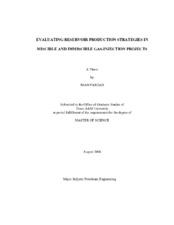| dc.description.abstract | Miscible gas injection processes could be among the most widely used enhanced oil recovery processes. Successful design and implementation of a miscible gas injection project depends upon the accurate determination of the minimum miscibility pressure (MMP) and other factors such as reservoir and fluid characterization. The MMP indicates the lowest pressure at which the displacement process becomes multicontact miscible. The experimental methods available for determining MMP are both costly and time consuming. Therefore, the use of correlations that prove to be reliable for a wide range of fluid types would likely be considered acceptable for preliminary screening studies. This work includes a comparative and critical evaluation of MMP correlations and thermodynamic models using an equation of state by PVTsim software.
Application of gas injection usually entails substantial risk because of the technological sophistication and financial requirements to initiate the project. More detailed, comprehensive reservoir engineering and project monitoring are necessary for typical miscible flood projects than for other recovery methods. This project evaluated effects of important factors such as injection pressure, vertical-to-horizontal permeability ratio, well completion, relative permeability, and permeability stratification on the recovery efficiency from the reservoir for both miscible and immiscible displacements. A three-dimensional, three-phase, Peng-Robinson equation of state (PR-EOS) compositional simulator based on the implicit-pressure explicit-saturation (IMPES) technique was used to determine the sensitivity of miscible or immiscible oil recovery to suitable ranges of these reservoir parameters.
Most of the MMP correlations evaluated in this study have proven not to consider the effect of fluid composition properly. In most cases, EOS-based models are more conservative in predicting MMP values. If screening methods identify a reservoir as a candidate for a miscible injection project, experimental MMP measurements should be conducted for specific gas-injection purposes.
Simulation results indicated that injection pressure was a key parameter that influences oil recovery to a high degree. MMP appears to be the optimum injection pressure since the incremental oil recovery at pressures above the MMP is negligible and at pressures below the MMP recovery is substantially lower.
Stratification, injection-well completion pattern, and vertical-to-horizontal permeability ratios could also affect the recovery efficiency of the reservoir in a variety of ways discussed in this work. | en |


